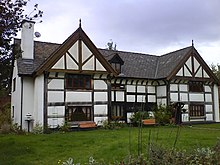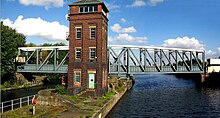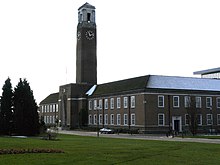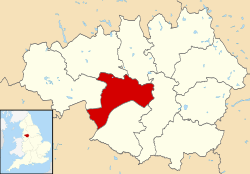
A | B | C | D | E | F | G | H | CH | I | J | K | L | M | N | O | P | Q | R | S | T | U | V | W | X | Y | Z | 0 | 1 | 2 | 3 | 4 | 5 | 6 | 7 | 8 | 9
Salford (/ˈsɒlfərd/ SOL-fərd),[7] also known as the City of Salford, is a metropolitan borough with city status in Greater Manchester, England. The borough is named after its main settlement, Salford, but covers a larger area which includes the towns of Eccles, Swinton, Walkden and Pendlebury. [8] The borough had a population of 278,064 in 2022,[4] and is administered from the Salford Civic Centre in Swinton.
Salford is the historic centre of the Salford Hundred an ancient subdivision of Lancashire. The City of Salford is the fifth-most populous district in Greater Manchester.[4] The city's boundaries, set by the Local Government Act 1972, include five former local government districts. It is bounded on the southeast by the River Irwell, which forms part of its boundary with Manchester to the east, and by the Manchester Ship Canal to the south, which forms its boundary with Trafford. The metropolitan boroughs of Wigan, Bolton, and Bury lie to the west, northwest, and north respectively. Some parts of the city, which lies directly west of Manchester, are highly industrialised and densely populated, but around one-third of the city consists of rural open space. The western half of the city stretches across an ancient peat bog, Chat Moss.
Salford has a history of human activity stretching back to the Mesolithic age. There are over 250 listed buildings in the city, including Salford Cathedral, and three Scheduled Ancient Monuments. With the Industrial Revolution, Salford and its neighboring settlements grew alongside the textile industry. The former County Borough of Salford was granted city status in 1926 and thus making it the second city in Greater Manchester after neighbouring Manchester. The city and its industries experienced a decline throughout much of the 20th century. Since the 1990s, parts of Salford have undergone regeneration, especially Salford Quays, home of BBC North and Granada Television, and the area around the University of Salford.
Salford Red Devils are a professional rugby league club in Super League and Salford City F.C. is a professional football club in League Two.
History


Although the metropolitan borough of the City of Salford was a 20th-century creation, the area has a long history of human activity, extending back to the Stone Age. Neolithic flint arrow-heads and tools, and evidence of Bronze Age activity has been discovered in Salford.[9] The northerly section of Watling Street, a Roman road from Manchester (Mamucium) via Bury to Ribchester (Bremetennacum), passes through the city;[10] a hoard of over 550 bronze Roman coins dating between 259 AD and 278 AD was discovered in Boothstown;[11] and a Romano-British bog body, Worsley Man, was discovered in the Chat Moss peat bog.[12]
In 1142, a monastic cell (small monastic house) dedicated to St. Leonard was established in Kersal.[10] The 12th century hundred of Salford was created as Salfordshire in the historic county of Lancashire and survived until the 19th century,[13] when it was replaced by one of the first county boroughs in the country. Salford became a free borough in about 1230,[14] when it was granted a charter as a free borough by the Earl Ranulph of Chester.[15] The cell in Kersal was sold in 1540 during the Dissolution of the Monasteries.[10] A 16th-century manor house, called Kersal Cell, was built on the site of the priory.[16] In the English Civil War between King Charles I and parliament, Salford was Royalist.[17] Salford was also noted as Jacobite territory; its inhabitants supported Charles Edward Stuart's claim to the Kingdom of Great Britain and hosted him when he rode through the area during the Jacobite rising of 1745.[17]

During the Industrial Revolution, Salford grew as a result of the textile industry.[18] Although Salford experienced an increase in population, it was overshadowed by the dominance of Manchester and did not evolve as a commercial centre in the same way.[19] On 15 September 1830, Eccles was site of the world's first railway accident.[20] During a stop in Eccles to take on water, William Huskisson, Member of Parliament for Liverpool, had his leg crushed by Stephenson's Rocket; at the time he was in conversation with the Duke of Wellington, who was opening the railway, and did not get out of the way of the train in time. Although Huskisson was taken to Eccles for treatment he died of his injuries.[21] The six-foot-tall Oglala Sioux tribesman, "Surrounded By the Enemy", died here from a bronchial infection at age twenty-two in 1887 during a tour of Buffalo Bill's Wild West Show and was buried at Brompton Cemetery.[22] In 1894, the Manchester Ship Canal was opened, running from the River Mersey to Salford Quays; when it was complete it was the largest navigation canal in the world.[23] Along the route of the canal, it was necessary to create an aqueduct carrying the Bridgewater Canal over the Ship Canal. The Barton Swing Aqueduct, designed by Sir Edward Leader Williams,[24] is 100 metres (330 ft) long and weighs 1,450 metric tons (1,427 long tons; 1,598 short tons).[25][26]
At the start of the 20th century, Salford began to decline due to competition from outside the UK. A survey in 1931 concluded that parts of Salford were amongst the worst slums in the country.[27] Salford was granted city status in 1926.[28] During World War II, Salford Docks were regularly bombed.[29]
In the decades following the Second World War there was a significant economic and population decline in Salford.[30] In 1961 a small part of Eccles was added to the city. On 1 April 1974, the City and County Borough of Salford was abolished under the Local Government Act 1972, and was replaced by the metropolitan borough of City of Salford, one of ten local government districts in the new metropolitan county of Greater Manchester.[13][31] The city status of the new district was confirmed by additional letters patent issued on the same day.[32] Since the early 1990s, the decline has slowed.[30]
Prior to the metropolitan borough's creation, the name Salford for the new local government district courted controversy. Salford was "thought second-class by those in Eccles", who preferred the new name "Irwell" for the district (with reference to the River Irwell).[33] A councillor for the then City and County Borough of Salford objected to this suggestion, stating this label was nothing but "a dirty stinking river".[33] The name Irwell won 8 votes to Salford's 7, but a private protest and deliberation favoured Salford as the name for the new city, citing that the River Irwell would pass through two other Greater Manchester districts, and that it "doesn't touch Worsley".[33]
Geography

The City of Salford is bounded to the north by the Metropolitan Borough of Bolton and Metropolitan Borough of Bury. To the south by the Metropolitan Borough of Trafford and to the west by the Metropolitan Borough of Wigan. Manchester lies directly across the river from Salford. The natural mossland of Chat Moss lies in the south western corner of the city; it covers an area of about 10.6 square miles (27.5 km2), accounting for about 30% of the city's area,[34] and lies 75 feet (23 m) above sea level.[35] The moss makes up the largest area of prime farmland in Greater Manchester.[34] Kersal Moor is an area of moorland spanning 8 hectares (20 acres) in Kersal; it is a local nature reserve and a Site of Biological Importance.[36][37] Greenspace accounts for 55.7% of the City of Salford's total area, domestic buildings and gardens comprise 20.0%, and the rest is made up of roads and non-domestic buildings.[38]
To the south of Salford are the docks of Salford Quays, now home to the MediaCityUK. MediaCityUK is a large area that crosses the boundary into Trafford Park, Trafford. Although Salford Quays is in the City of Salford and has created job opportunities and more housing since the 2010s when it was built.
The River Irwell runs south east through Kearsley, Clifton and Agecroft then meanders around Lower Broughton and Kersal, Salford Crescent and the centre of Manchester, joining the rivers Irk and Medlock. Turning west, it meets the Mersey south of Irlam, where the route of the river was altered in the late 19th century to form part of the course of the Manchester Ship Canal. The ship canal, opened in 1894, forms part of Salford's southern boundaries with Trafford.[39] The city's climate is generally temperate, like the rest of Greater Manchester. The nearest weather station is 10 miles (16 km) away at Ringway, in Manchester; the mean highest and lowest temperatures (13.2 °C (55.8 °F) and 6.4 °C (43.5 °F)) are slightly above the national average, while the annual rainfall (806.6 millimetres (31.76 in)) and average hours of sunshine (1394.5 hours) are respectively above and below the national averages.[40][41]
Governance

Parliamentary constituencies
The City of Salford is represented by Members of Parliament (MPs) for three constituencies, Salford and Eccles by Rebecca Long-Bailey (Labour),[42] Worsley and Eccles South by Barbara Keeley (Labour),[43] and the Broughton and Kersal wards of Salford in Blackley and Broughton by Graham Stringer (Labour).[44]
Council
In 1974, Salford City Council was created to administer the newly formed local government district. Until 1986, it shared power with the Greater Manchester County Council. The council offices are in Swinton, in what was formerly Swinton and Pendlebury Town Hall. The Labour Party have been in control of the council since its formation in 1974.[45] The council has a constitution detailing how they should operate in performing their duties.[46]
Salford City Council was assessed by the Audit Commission and judged to be "improving well" in providing services for local people. Overall the council was awarded "three star" status meaning it was "performing well" and "consistently above minimum requirements", similar to 46% of all local authorities.[47]
The metropolitan borough of the City of Salford is based on the former County Borough of the City of Salford which included the city centre, Pendleton, Weaste, Claremont, Langworthy, Broughton, Kersal, Ordsall and Seedley. The city is entirely unparished and absorbed the municipal boroughs of Eccles and Swinton and Pendlebury and the urban districts of Irlam and Worsley. An urban district was a type of local government district which covered an urbanised area.
Since 2012, in addition to the long-existing and largely ceremonial, annually appointed civic mayor of Salford, the city has also had a directly elected mayor.
| Party | Seats in 2022 | |
|---|---|---|
| Labour | 49 | |
| Conservative | 8 | |
| Lib Dems | 2 | |
| Independent | 1 | |
Electoral wards
There are 60 councillors representing 20 wards. Swinton and Walkden have six councillors each.[48]
| Ward name | Area (ha)/mi2 | Population (2014) |
|---|---|---|
| Barton | 244 hectares (0.94 sq mi) [49] | 12,462 [50] |
| Boothstown and Ellenbrook | 860 hectares (3.3 sq mi) [51] | 9,532 [52] |
| Broughton | 267 hectares (1.03 sq mi) [53] | 14,916 [54] |
| Cadishead | 1,476 hectares (5.70 sq mi) [55] | 10,739 [56] |
| Claremont | 190 hectares (0.73 sq mi)[57] | 10,166 [58] |
| Eccles | 270 hectares (1.0 sq mi) [59] | 11,499 [60] |
| Irlam | 935 hectares (3.61 sq mi) [61] | 9,857 [62] |
| Irwell Riverside | 451 hectares (1.74 sq mi) [63] | 12,939 [64] |
| Kersal | 313 hectares (1.21 sq mi) [65] | 12,929 [66] |
| Langworthy | 203 hectares (0.78 sq mi) [67] | 12,980 [68] |
| Little Hulton | 452 hectares (1.75 sq mi) [69] | 13,469 [70] |
| Ordsall | 414 hectares (1.60 sq mi) [71] | 16,725 [72] |
| Pendlebury | 662 hectares (2.56 sq mi) [73] | 13,434 [74] |
| Swinton North | 349 hectares (1.35 sq mi) [75] | 11,473 [76] |
| Swinton South | 281 hectares (1.08 sq mi) [77] | 11,458 [78] |
| Walkden North | 448 hectares (1.73 sq mi) [79] | 12,232 [80] |
| Walkden South | 361 hectares (1.39 sq mi) [81] | 10,185 [82] |
| Weaste and Seedley | 354 hectares (1.37 sq mi) [83] | 12,616 [84] |
| Winton | 370 hectares (1.4 sq mi) [85] | 12,339 [86] |
| Worsley | 838 hectares (3.24 sq mi) [87] | 10,090 [88] |
Central Salford and Salford West
The district is divided into two areas (Central Salford and Salford West)[89] for some purposes including planning, regeneration and housing.
- Central Salford is the eastern part of the district and comprises seven wards: Broughton, Claremont, Irwell Riverside, Kersal, Ordsall, Langworthy and Weaste & Seedley. This is the more urban half of the district and lies partly within the Manchester Inner Ring Road. Salford Quays lies within this area. Between 2005 and 2011, the Central Salford Urban Regeneration Company was responsible for urban regeneration in this area, securing over £1 billion of private sector investment.[90] Social housing is provided by Salix Homes in this area.
- Salford West comprises the other 13 wards, including the towns of Eccles, Pendlebury, Swinton and Walkden. This is the more suburban and rural half of the district. Salford City Council's aspiration is that "In 2028, Salford West will be one of the most desirable and prosperous areas in Greater Manchester."[91] Social housing is provided by City West Housing Trust in this area.
Coat of arms

|
|
The coat of arms of Salford City Council depicts a weaving shuttle surrounded by five bees with a three masted ship above, on a shield flanked by two lions.[93] The blue background with a gold chief is taken from the arms of the city council of the County Borough of Salford, who in turn took it from the colours of the Earl of Chester. The shuttle and five bees represent the industry of the area and five settlements who benefited from the textile industry.[93] The ship is borrowed from the crest of Eccles Borough Council and represents the importance of waterways to the city. The ship is flanked by two millrinds – the iron centres of millstones – symbolising engineering.[93] The lions are taken from the crest of the Borough of Swinton and Pendlebury; they are wearing iron steel chain representing engineering. The shield is topped by a griffin carrying a pennon depicting three boars' heads. The griffin is taken from the crest of Eccles and the boars are from the crest of Irlam Urban District.[93] Beneath the shield is a scroll reading salus populi suprema lex, Latin for "the welfare of the people is the highest law".[93]
Budget
In 2017–18, Salford City Council agreed to spend £267 million. They agreed an estimated £79M on children's services (30%); £56M on community health and social care (21%); £40M on levies and charges (15%); £39M on environment and community safety (14%); £36M and on capital financing (13%); £9M on corporate business (3%); £7M on regeneration (3%); and £2M on public health, reform and commissioning (1%). For the 2016–17 financial year, the council's income is expected to consist of £65M including council tax and efficiency savings. The net expenditure is therefore expected to be £202M.[94]
Audit
A Comprehensive Area Assessment by the Audit Commission in 2009 found that Salford's key priorities are improving health, reducing crime, helping young people achieve A-level qualifications, social services, including the views of minority groups, improving skills and "making Salford a cleaner and more attractive place to live".[95]
Demography
Ethnicity
| Ethnic Group | Year | |
|---|---|---|
| 2021[96] | ||
| Number | % | |
| White: Total | 222,248 | 82.4 |
| White: British | 199,614 | 74.0 |
| White: Irish | 2,882 | 1.1 |
| White: Roma | 515 | 0.2 |
| White: Gypsy or Irish Traveller | 295 | 0.1 |
| White: Other | 18,942 | 7.0 |
| Asian or Asian British: Total | 14,938 | 5.5 |
| Asian or Asian British: Indian | 3,744 | 1.4 |
| Asian or Asian British: Pakistani | 4,074 | 1.5 |
| Asian or Asian British: Bangladeshi | 803 | 0.3 |
| Asian or Asian British: Chinese | 3,319 | 1.2 |
| Asian or Asian British: Other Asian | 2,998 | 1.1 |
| Black or Black British: Total | 16,473 | 6.1 |
| Black or Black British: African | 13,477 | 5.0 |
| Black or Black British: Caribbean | 1,338 | 0.5 |
| Other Black | 1,658 | 0.6 |
| Mixed or British Mixed: Total | 8,501 | 3.2 |
| Mixed: White and Black Caribbean | 2,596 | 1.0 |
| Mixed: White and Black African | 2,098 | 0.8 |
| Mixed: White and Asian | 1,844 | 0.7 |
| Mixed: Other Mixed | 1,963 | 0.7 |
| Other: Total | 7,762 | 2.9 |
| Other: Arab | 3,214 | 1.2 |
| Other: Any other ethnic group | 4,548 | 1.7 |
| Total | 269,923 | 100% |
At the 2011 UK census, the City of Salford had a total population of 233,933.[97] Of the 103,556 households in Salford, 25.4% were married or same-sex civil partnership couples living together, 36.4% were one-person households, 11.2% were co-habiting couples and 13.5% were lone parents. The figures for lone parent households were above the national average of 10.6%, and the percentage of married couples was also below the national average of 33.2%; the proportion of one person households was higher than the national average of 30.3%.[98]
The population density was 24.1 persons per hectare (Salford covers 9,719 hectares), 117,151 (50.1%) female, and 116,782 (49.9%) male.[99] Of those aged 16–74 in Salford, 27.1% had no academic qualifications, significantly higher than 22.5% in all of England.[100] 11.8% of Salford's residents were born outside the United Kingdom, lower than the national average of 13.8%.[101] The largest minority group was recorded as Asian, at 4.1% of the population.[102]
The number of theft from a vehicle offences and theft of a vehicle per 1,000 of the population was 21.3 and 7.9 compared to the English national average of 7.6 and 2.9 respectively.[103] The number of sexual offences was 1.1 compared to the average of 0.9.[103] The national average of violence against another person was 16.7 compared to the Salford average of 27.2.[103] The figures for crime statistics were all recorded during the 2006/7 financial year.[104] Although all were above the averages for England, Salford's crime rate was lower than Manchester's.[105]
Population change

The table below details the population change since 1801, including the percentage change since the last available census data. Although the City of Salford has existed as a metropolitan borough since 1974, figures have been generated by combining data from the towns, villages, and civil parishes that would later be constituent parts of the city.
|
|
| |||||||||||||||||||||||||||||||||||||||||||||||||||||||||||||||||||||||||||
| Source: Vision of Britain[106] | |||||||||||||||||||||||||||||||||||||||||||||||||||||||||||||||||||||||||||||
Religion


The following table shows the religious identity of residents residing in the city of Salford.



